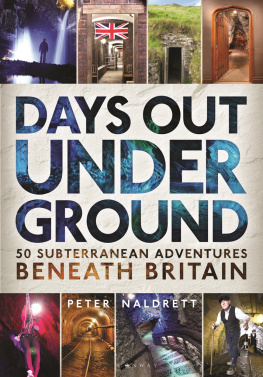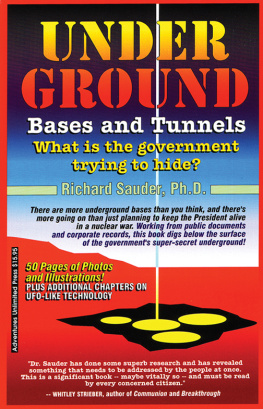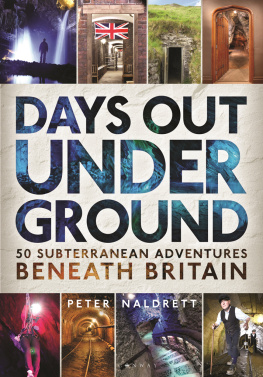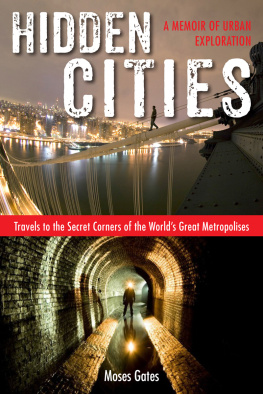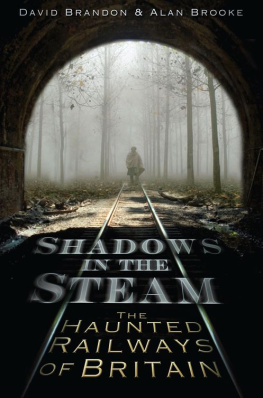For Nicola, Toby and Willow. Thanks for going underground!
CONWAY
Bloomsbury Publishing Plc
50 Bedford Square, London, WC1B 3DP, UK
This electronic edition published in 2019 by Bloomsbury Publishing Plc
BLOOMSBURY, CONWAY and the Conway logo are trademarks of Bloomsbury Publishing Plc
First published in Great Britain 2019
Copyright Peter Naldrett, 2019
Peter Naldrett has asserted his right under the Copyright, Designs and Patents Act, 1988, to be identified as Author of this work
For legal purposes the constitute an extension of this copyright page
All rights reserved
You may not copy, distribute, transmit, reproduce or otherwise make available this publication (or any part of it) in any form, or by any means (including without limitation electronic, digital, optical, mechanical, photocopying, printing, recording or otherwise), without the prior written permission of the publisher. Any person who does any unauthorised act in relation to this publication may be liable to criminal prosecution and civil claims for damages.
Bloomsbury Publishing Plc does not have any control over, or responsibility for, any third-party websites referred to or in this book.
All internet addresses given in this book were correct at the time of going to press. The author and publisher regret any inconvenience caused if addresses have changed or sites have ceased to exist, but can accept no responsibility for any such changes
A catalogue record for this book is available from the British Library
Library of Congress Cataloguing-in-Publication data has been applied for
ISBN 978-1-8448-6567-3 (PB)
ISBN 978-1-8448-6566-6 (eBook)
ISBN 978-1-8448-6568-0 (ePDF)
Illustration by David Broadbent
To find out more about our authors and their books please visit www.bloomsbury.com where you will find extracts, author interviews and details of forthcoming events, and to be the first to hear about latest releases and special offers, sign up for our newsletter.

CONTENTS

INTRODUCTION

Mysterious passageways and underground routes can be found all over Britain, including this tunnel looking out on Westminster.
THE MYSTERY OF WHAT LIES BENEATH our feet has captured the human imagination for millennia. There has always been a fascination with what well find when we dig down into the ground, how the raw materials hidden below may be able to advance our society, how we can entertain ourselves in the depths.
The earth beneath has provided humans with places to shelter, metals to make tools and weapons, power to feed machinery and the sanctuary to escape our own self-destruction. At the same time, forces under the Earths surface have moved tectonic plates, causing earthquakes and volcanoes that have destroyed towns and cities. What lies beneath has both allowed civilisations to move forward and randomly checked our progress in unforgiving ways.
We know the immense potential that sits between us and the centre of the Earths core, some 6,371km away, with a temperature approaching an unimaginable 6,000C. And yet here we are in the 21st century, having barely scratched the surface of our underground world. The deepest point ever reached by humans on land is at the bottom of a gold mine in South Africa. Thats a mere 4km down from the fresh air and daylight at ground level. Its less than 0.01% of the distance to the core.
Its intrigue fuelled by its inaccessibility, getting down into the bowels of the Earth has long fired the imagination of storytellers. The Greeks passed down accounts of Hades, god of the Underworld, dwelling in the depths of the planet. The great French adventure novelist Jules Verne described a fantastical trip to the Earths core through the Icelandic mountain Snfell in Journey to the Centre of the Earth. The literary underground gauntlet was picked up by HG Wells at the end of the Victorian era, when he penned The Time Machine. Set thousands of years in the future, it depicts a new species, the Morlocks, who live underground and provide goods for the surface-dwelling Eloi and, in return, feed on their bodies. Meanwhile, in Wellss The War of the Worlds, the potential for starting a new life underground is explored by desperate victims of the Martians. Through the centuries, venturing down below has brought with it a sense of fear and adventure.
In the United Kingdom, digging deep has helped us to develop as a nation. Thousands of years ago, early Britons like Cheddar Man (whose remains were found in Goughs Cave in Cheddar Gorge) took shelter in natural caves to escape the elements and fierce predators. Tin miners in Cornwall traded with people working with copper ore in North Wales to create a new metal that could make pioneering tools and weapons, and that gave its name to their time period the Bronze Age. Thousands sweated and toiled in mines to bring out the coal that powered the Industrial Revolution and the slate that still keeps the rain out of our houses. Whole communities have relied on the incomes paid to hard-working adults and children who disappeared into the darkness for shift after challenging shift.
When the dark years of World War II loomed over Europe, huge underground shelters in towns like Ramsgate, Stockport and Newcastle saved countless lives. Meanwhile, hidden passages in London, Dover and Liverpool allowed the war effort to be planned and executed without interruption. When the Cold War brought an icy chill to the continent, government strategists planning for a nuclear apocalypse again looked below ground for a solution. Bunkers in Essex and Fife contributed to a network of subterranean strongholds that, had it been necessary, would have attempted to maintain the rule of law and broadcast essential information to the nation.
Many of these places are no longer used, but instead an army of underground employees in the tourist industry now works below the surface to welcome you into these hidden depths that are so interlocked with the history of our nation. Many of them are unusual, some are bizarre and there are a few that are wonderfully eerie. Together, they provide the perfect solution for people wanting to try a different type of day out and an antidote to the conventional trips families tend to stick to on the surface. Visiting all 50 of the attractions in this book will take you on a fascinating journey of discovery through Britains social and economic past, from early geological processes to the first settlers travelling across Doggerland; from the first miners honing raw materials to the incredible feats of engineering involved in developing transport and sewage systems; from hidden underground cables built to make the world metaphorically smaller to the hedonistic adventures of climbers in old slate mines. This enthralling collection of underground attractions is a rich resource for adventurous grown-ups and children alike; together, they convey the essence of British history and of the ordinary folk who spent years working in them.
Ive thoroughly enjoyed my journey around Britain discovering places beneath the surface. Theres a whole load of fun to be had down there. So get ready to go underground!

